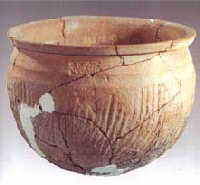| Chinese Way > Daily Highlight |
|
|
Food for Thought: Archeological Findings Point to Chinese Dietary Culture
First, let's take a look at cooking skills and traditional cookers of ancient times. Cooking, roasting, steaming, rinsing are the four basic ways of Chinese cooking. ** Cooking Cooking originated in the New Stone Age more than 10,000 years ago when pottery was first invented. Pottery kettles and dings (ancient cooking vessels) were mainly used to cook food. Prehistoric cooking vessels unearthed in China have several notable characteristics. Take the ding for example, which is actually a tripod kettle. The nine-ding tripod was once the symbol for central authority and whoever possessed a tripod, seized sovereign power. It is said that the nine-ding was lost during the reign of Emperor Qinshihuang, the first emperor that unified China.
Cooking is prevalent both in China and abroad, but it was first practiced in
China over 10,000 years ago. For example, a porcelain
kettle from the New Stone Age site of the 10,000-year-old Fairy Cave in East
China's Jiangxi
Province, which features a very simple design and a round base at the
bottom, is the oldest cooking vessel known to man. Other findings at the Hemudu
Culture site include kitchen ranges and kettles -- both made of pottery and
featured advanced craftsmanship. In fact, kitchen ranges were portable and are
believed to be the origin of today's famous hot pots.
|
||||||||||
 |

 Cooking methods and cookers
Cooking methods and cookers